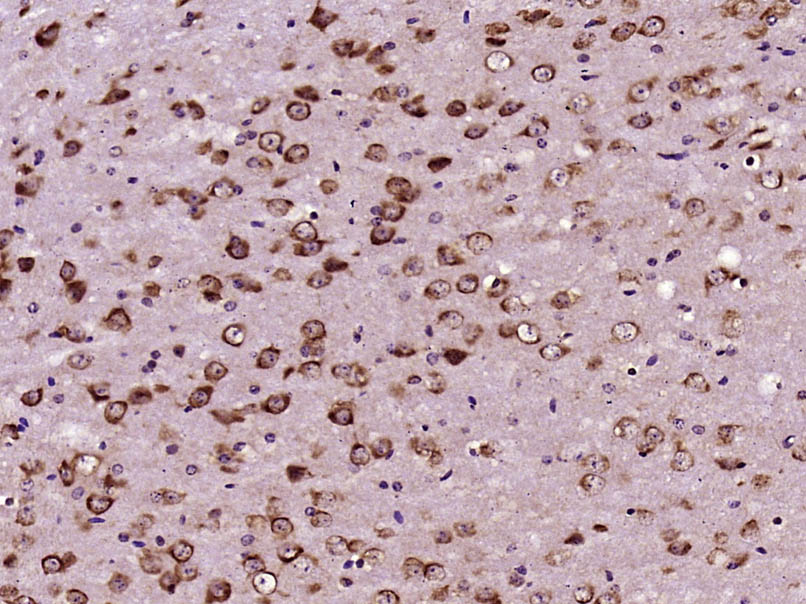
Rabbit Anti-CEP290 antibody
3H11AG; Bardet-Biedl syndrome 14 protein; BBS14; Cancer/testis antigen 87; CE290_HUMAN; Centrosomal protein 290kDa; Centrosomal protein of 290 kDa; Cep290; CT87; CTCL tumor antigen se2 2; FLJ13615; FLJ21979; JBTS5; JBTS6; KIAA0373; LCA10; Meckel syndrome,
View History [Clear]
Details
Product Name CEP290 Chinese Name 中心体蛋白290抗体 Alias 3H11AG; Bardet-Biedl syndrome 14 protein; BBS14; Cancer/testis antigen 87; CE290_HUMAN; Centrosomal protein 290kDa; Centrosomal protein of 290 kDa; Cep290; CT87; CTCL tumor antigen se2 2; FLJ13615; FLJ21979; JBTS5; JBTS6; KIAA0373; LCA10; Meckel syndrome, type 4; MKS4; Monoclonal; 3H11 antigen; Nephrocystin 6; Nephrocystin-6; NPHP6; POC3; POC3 centriolar protein homolog; Prostate cancer antigen T21; rd16; SLSN6 1, 2, 5; SLSN6; Tumor antigen se2-2. Research Area Cell biology Neurobiology Signal transduction Epigenetics Immunogen Species Rabbit Clonality Polyclonal React Species Mouse, (predicted: Human, Rat, Dog, Cow, Horse, Sheep, ) Applications ELISA=1:5000-10000 IHC-P=1:100-500 IHC-F=1:100-500 ICC=1:100-500 IF=1:100-500 (Paraffin sections need antigen repair)
not yet tested in other applications.
optimal dilutions/concentrations should be determined by the end user.Theoretical molecular weight 291kDa Cellular localization cytoplasmic Form Liquid Concentration 1mg/ml immunogen KLH conjugated synthetic peptide derived from human CEP290: 131-230/2479 Lsotype IgG Purification affinity purified by Protein A Buffer Solution 0.01M TBS(pH7.4) with 1% BSA, 0.03% Proclin300 and 50% Glycerol. Storage Shipped at 4℃. Store at -20 °C for one year. Avoid repeated freeze/thaw cycles. Attention This product as supplied is intended for research use only, not for use in human, therapeutic or diagnostic applications. PubMed PubMed Product Detail This gene encodes a protein with 13 putative coiled-coil domains, a region with homology to SMC chromosome segregation ATPases, six KID motifs, three tropomyosin homology domains and an ATP/GTP binding site motif A. The protein is localized to the centrosome and cilia and has sites for N-glycosylation, tyrosine sulfation, phosphorylation, N-myristoylation, and amidation. Mutations in this gene have been associated with Joubert syndrome and nephronophthisis and the presence of antibodies against this protein is associated with several forms of cancer. [provided by RefSeq, Jul 2008
Function:
Activates ATF4-mediated transcription. Required for the correct localization of ciliary and phototransduction proteins in retinal photoreceptor cells; may play a role in ciliary transport processes.
Subcellular Location:
Cytoplasm > cytoskeleton > centrosome. Nucleus. Cell projection > cilium. Connecting cilium of photoreceptor cells, base of cilium in kidney intramedullary collecting duct cells.
Tissue Specificity:
Ubiquitous. Expressed strongly in placenta and weakly in brain.
DISEASE:
Defects in CEP290 are a cause of Joubert syndrome type 5 (JBTS5) [MIM:610188]. Joubert syndrome is an autosomal recessive disease characterized by cerebellar vermis hypoplasia with prominent superior cerebellar peduncles (the 'molar tooth sign' on axial magnetic resonance imaging), psychomotor delay, hypotonia, ataxia, oculomotor apraxia and neonatal breathing abnormalities. JBTS5 shares the neurologic and neuroradiologic features of Joubert syndrome together with severe retinal dystrophy and/or progressive renal failure characterized by nephronophthisis.
Defects in CEP290 are a cause of Senior-Loken syndrome type 6 (SLSN6) [MIM:610189].
Senior-Loken syndrome is also known as juvenile nephronophthisis with Leber amaurosis. It is an autosomal recessive renal-retinal disorder, characterized by progressive wasting of the filtering unit of the kidney, with or without medullary cystic renal disease, and progressive eye disease.
Defects in CEP290 are the cause of Leber congenital amaurosis type 10 (LCA10) [MIM:611755]. LCA designates a clinically and genetically heterogeneous group of childhood retinal degenerations, generally inherited in an autosomal recessive manner. Affected infants have little or no retinal photoreceptor function as tested by electroretinography. LCA represents the most common genetic cause of congenital visual impairment in infants and children.
Defects in CEP290 are the cause of Meckel syndrome type 4 (MKS4) [MIM:611134]. MKS4 is an autosomal recessive disorder characterized by a combination of renal cysts and variably associated features including developmental anomalies of the central nervous system (typically encephalocele), hepatic ductal dysplasia and cysts, and polydactyly. Note=Antibodies against CEP290 are present in sera from patients with cutaneous T-cell lymphomas, but not in the healthy control population.
Defects in CEP290 are the cause of Bardet-Biedl syndrome type 14 (BBS14) [MIM:209900]. A syndrome characterized by usually severe pigmentary retinopathy, early-onset obesity, polydactyly, hypogenitalism, renal malformation and mental retardation. Secondary features include diabetes mellitus, hypertension and congenital heart disease.
Inheritance is autosomal recessive, but three mutated alleles (two at one locus, and a third at a second locus) may be required for disease manifestation in some cases (triallelic inheritance).
SWISS:
O15078
Gene ID:
80184
Database links:Entrez Gene: 80184 Human
Omim: 610142 Human
wissProt: O15078 Human
Unigene: 150444 Human
Product Picture
References (0)
No References
Bought notes(bought amounts latest0)
No one bought this product
User Comment(Total0User Comment Num)
- No comment



 +86 571 56623320
+86 571 56623320
 +86 18668110335
+86 18668110335

